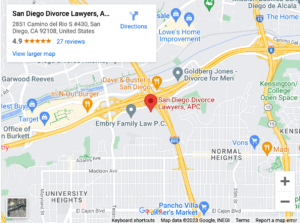California Divorce Process

Getting a divorce can be overwhelming.
Preparing yourself by learning about the process – and what to expect throughout – can help to make a tough situation a little bit easier.
Here’s what you need to know about the divorce process in the state of California, San Diego.
Table of Contents
Beginning The Divorce Process
The divorce process begins when one spouse – known as the petitioner – formally files divorce papers in California with their local court and pays the necessary filing fees.
These papers include the:
- Summons (FL-110)
- Petition for Dissolution (FL-100),
- Preliminary Declaration of Disclosure (FL-140), and
- Any necessary attachments or forms.
If, for example, you have children under the age of 18, you’ll also need to file a Declaration Under the Uniform Child Custody Jurisdiction and Enforcement Act.
Summons: The summons is the document that initiates the divorce process.
It lets one spouse tell the other that a formal legal proceeding has been initiated. The summons also effectively operates as a restraining order, prohibiting each spouse from tampering with assets or engaging in behavior that could harm the divorce proceedings.
Petition: The petition provides important details about the couple, their marriage, and the requested divorce. It’s also used to propose a list of terms to resolve the divorce, including, but not limited to:
- Attorney fees
- Child custody
- Child support
- Alimony, and
- Property division.
The petition typically only reflects the petitioning spouse’s wishes. The respondent will also have an opportunity to weigh in after the divorce papers have been served.
Preliminary Declaration of Disclosure: This form is actually required within 60 days after the divorce papers are filed and served. Both spouses have to be transparent about their finances, the property they hold, and any debts they may have. The form should include an attachment that lists all assets and debts.
Serving Divorce Papers in California
The petitioner has an obligation to make sure that the other spouse – known as the respondent – gets a copy of any divorce papers filed with the court. This helps to ensure that both spouses are fully aware of what’s going on and that each has the opportunity to participate in the process. This is achieved using a process called “Service.”
The state of California has strict rules about how divorce papers can be served. Deviating from these set procedures can delay the divorce process and really complicate matters. It’s very important to make sure that your divorce papers are served properly.
Initially, divorce papers are typically to be delivered through personal service. This means that the respondent (the spouse being served with divorce papers) has to be physically handed copies of the summons and other paperwork. You can’t serve the divorce papers yourself. You have to hire a professional server or have an uninterested third party (who’s at least 18) serve the papers on your behalf.
It can make sense to hire a professional process server if you suspect that your spouse will resist your efforts to get a divorce.
You may also be able to use an alternative form of service – such as service by mail – if your spouse agrees.
PROOF OF SERVICE
It’s not enough to serve the divorce papers. You’ll also have to get proof that your spouse got the documents. The process server will have to complete a Proof of Service form (FL-115). Once the Proof of Service form is filed with the court, the divorce process will formally begin.
How to Respond To Divorce Papers
When your spouse files the divorce papers with the court, they get the ball rolling. In the divorce papers, the petitioner proposes solutions for issues like:
- Child custody
- Child support
- Alimony
- The division of community property.
Just because the petitioner requests certain terms in the initial filing doesn’t mean that those terms will be honored.
The spouse who is served with divorce papers also has an opportunity to address any issues related to the dissolution of marriage. This is done by filing a Response (FL-120) with the court clerk. You’ll also have to serve a copy of the Response on your spouse using personal service or the mail.
However, a clock starts to run the moment you’re served with divorce papers. You’ll have 30 days from the date of service to formally respond to the papers. When you respond, you can agree to the terms presented by your spouse or propose some of your own.
How (and if) you respond to the divorce papers will dictate what type of divorce you have.
Uncontested Divorce: Your divorce will be considered uncontested if you respond to the divorce papers and agree to all of the terms proposed in the initial divorce filing. Those terms will generally be granted.
Contested Divorce: Your divorce will be considered contested if you respond to the divorce papers and disagree with any of your spouse’s proposed terms. You’ll have a contested divorce even if you disagree about one of the terms in your spouse’s initial filing.
What Happens If I Don’t Respond To The Divorce Papers?
In California, you can’t contest a divorce. You can only contest the terms. If one spouse wants and files for divorce, it will happen, regardless of how the other spouse feels. So, the divorce process will move forward even if you ignore the divorce papers.
If you fail to respond to the divorce papers within 30 days of service you’ll have what is known as a “default.” When faced with a true default, the court will generally approve the terms proposed by the petitioning spouses and finalize the divorce to reflect those arrangements. You’ll still be required to comply with those terms even if you’ve chosen not to participate in the process, at all.
What Happens After The Papers Are Filed And Served in California?
Once the divorce papers have been filed and served, the next step in the process will depend on the type of divorce you have.
How Long Does it Takes for a Judge to Sign a Divorce in California?
For an uncontested divorce, you’ll just have to sit tight until California’s minimum waiting period has expired. A judge can’t sign off on your divorce until at least six months after the papers have been served. When six months have gone by, the judge will sign a judgment granting you a divorce. The terms in the initial divorce filing will be effective and binding on both spouses.
Things are a bit more complicated when you have a contested divorce. You and your spouse will have to try to figure out how to resolve the terms of your split. It’s typically in your best interest to do this on your own and avoid going to court. Why? Because:
- Going to court is time-consuming and expensive, and
- You forfeit control over how important aspects of your divorce are resolved.
Since you and your spouse are ending your marriage, it might be difficult for you to sit down and agree on what your divorce should look like. You may want spousal support, and your spouse might be adamant that they’re not paying. Alternatively, you might have huge differences in opinion regarding how your marital assets should be divided.
Fortunately, there are tools available to help you navigate these issues without having to go in front of a judge.
Mediation: Mediation allows you and your spouse to sit down with a neutral third party to discuss terms relevant to your divorce. The mediator isn’t there ot make decisions for you. Instead, the mediator is there to help you both see the bigger picture, find common ground, and find a compromise. Mediation can be great because you (and your spouse) get the final say.
Arbitration: Arbitration can be beneficial if you don’t think that you and your spouse will be able to get on the same page about the terms of your divorce. You can go to arbitration to hash out all of the terms, or just specific ones on which you can’t reach an agreement. During arbitration, you and your spouse will each argue your side of the story to a neutral third party known as an arbitrator. Here, however, you don’t have control over the outcome. The arbitrator is the judge and makes binding decisions based on the information and evidence in front of them. Whatever the arbitrator says is final.
What If My Divorce Goes To Court?
Sometimes there will be cases when spouses cannot agree on the terms of their divorce. When alternatives don’t work out, couples are left with no choice but to take their case in front of a judge. Here’s an overview of what to expect if your divorce case goes to trial.
Schedule a Trial Date: Before a divorce, matter can go to trial, a judge has to set a trial date. This happens when a spouse submits a formal request to the court. A judge will often require spouses to exhaust all alternatives to court before a trial date is scheduled. In other words, you’ll probably have to at least try mediating your issues before you’ll get a trial date.
Temporary Orders: Once divorce proceedings have begun, spouses can ask a court to issue temporary orders. It’s common for courts to receive requests for orders related to child custody and spousal support. A court may also issue a temporary restraining order if there are any allegations of domestic violence.
The order is only effective for the duration of the divorce process. Once the terms are finalized, those will become effective.
Pre-Trial Discovery: Before trial, both spouses will have the opportunity to engage in a discovery process. During discovery, each spouse (or related parties) can be compelled to hand over documents and information that are relevant to the divorce proceedings. This might include things like bank records, medical records, employment records, or business holdings. The purpose of discovery is to make sure that both parties have all of the information they need before moving forward.
Depositions: Depositions aren’t uncommon during the pre-trial discovery process. A deposition is a testimony that’s given out of court under oath. Spouses can have the opportunity to depose related parties (e.g., family members, caretakers, friends) or expert witnesses (e.g., psychiatrists, financial experts, etc.) who can provide some valuable insight into details relevant to the divorce. The individuals who are deposed can potentially be recalled as witnesses should the case go to trial.
Trial: If you and your spouse are still at odds and haven’t resolved your issues, your attorney will get the opportunity to argue your side of the story in front of a judge. The judge will consider arguments, testimony, and evidence from both sides. Expert witnesses often play a critical role in divorce trials. If a divorce is being contested in court, it means that the spouses probably have very different views on at least one issue. Experts can relay unbiased information that can help a judge better understand the case at hand.
Once the trial has concluded, the judge will apply California state family law to the facts and evidence. The judge will use their experience, expertise, and discretion to make the best decisions for the specific case before them. Spouses are legally obligated to comply with the terms in a judge’s final ruling. This ruling is a court order. Ignoring or violating the terms can be considered contempt of court, which is punishable by steep fines and/or imprisonment.
When Is A Divorce Final?
Two things have to happen before a divorce can be finalized. First, at least six months must have passed since the divorce papers were served on the responding spouse. Second, all of the terms of the divorce must have been resolved. It doesn’t matter if the terms were negotiated with the assistance of a mediator or handed down by a judge in court. It just matters that all of the issues relevant to the divorce proceedings are settled.
Once both of these things have been satisfied, a judge will sign the divorce judgment, which is also known as the divorce decree. This judgment is the court order that not only terminates the marriage but also contains all of the terms of the divorce. A judgment may include several attachments, including, but not limited to:
- Spousal Support Order
- Child Custody and Visitation Order
- Property declarations, and
- Income declaration.
Once the divorce is final, you and your spouse will have to work to comply with the terms in the decree. This might involve dividing and allocating marital assets, assuming property and debt, transferring title to property from one spouse to another, and closing joint financial accounts.
Even though a divorce decree is final, the terms of a divorce can be changed. Either spouse can request to modify an order if things change in the future.
Divorce Is Complicated. We’re Here To Help.
Getting divorced can be an emotionally frustrating and overwhelming process. There are a lot of moving parts. You and your spouse probably don’t agree on every aspect of your impending split. As a result, tensions might run high, making it even more difficult to move forward. You don’t have to go through this on your own. Let the experienced San Diego family law attorneys at the San Diego Divorce Lawyers, APC help.
We’re different from other family law attorneys in San Diego. How? Our founder, Puja A. Sachdev, is a trained mediator. She’s a Certified Family Law Specialist. She’s a Certified Divorce Financial Analyst. No other divorce attorney in San Diego County can say the same. That means that our skilled legal team is uniquely qualified to handle all aspects of your divorce. We’ll be there for you every step of the way and fight to get your divorce resolved the way you want.
Contact our San Diego, CA law office to schedule your consultation today at (619) 866-3756. We’re here to take your call whenever you need us most.

